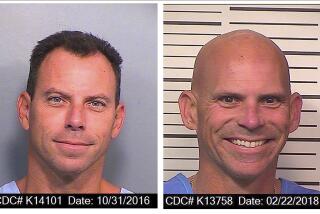Editorial: With Harry Reid’s retirement, will the Yucca Mountain plan be revived?
With the decommissioning of Diablo Canyon, the state’s last active nuclear power plant, looming in 2025, it might appear that the end of the nuclear age is in sight for California.
But sorry, no such luck. Not until the federal government makes good on its responsibility to find a permanent repository for spent nuclear fuel.
More than 70,000 tons of nuclear waste sit waiting at about 120 facilities across the nation, including more than 1,600 tons at the shuttered San Onofre Nuclear Generating Station and tons more at Diablo Canyon. It’s safe enough for the moment, but it is not an acceptable long-term solution.
Things may start to change as soon as next month for two reasons. First, Sen. Harry Reid is retiring. For two decades, Reid has been the chief opponent of siting a permanent underground nuclear waste dump at Yucca Mountain in his home state of Nevada. As leader of the Senate’s Democrats he had the power to cut funding for the project, and the support of President Barack Obama. As a result, the already slow permitting process for Yucca Mountain has been stalled since 2010.
The second change is that President-elect Donald Trump is apparently open to the idea of restarting the permitting process for the storage site. Although Reid’s replacement in the Senate, Sen.-elect Catherine Cortez Masto (D-Nev.), opposes Yucca Mountain, as does Sen. Dean Heller (R-Nev.), they don’t have the sway needed to stall the project if the Trump administration chooses to reinstate it. With the support of the Republican-controlled federal government, the process could move fairly quickly, though it’s unlikely it would open next year as had been planned.
Not to be insensitive to Nevadans, but thank goodness for that.
Of course, their concerns are understandable. No one wants tens of thousands of tons of radioactive garbage dumped nearby, especially given fears that it may someday leak into the groundwater. But for all its flaws, Yucca Mountain probably still represents the safest place in the country for a nuclear repository. It is dry, remote and stable, and it sits at the edge of a 1950s-era atomic testing site. More than $10 billion has already been spent developing the repository there. The fact is, no preferable alternative anywhere in the country has been identified, yet the waste has to go somewhere. That, in a nutshell, is the problem with nuclear power.
While the spent fuel is relatively safe for the moment being stored in casks or pools on the sites where it was generated, it’s not secure or cost-effective to keep the waste stored there forever. Ratepayers who have already paid fees to fund waste facilities are being asked to keep paying to babysit the waste long after some of the plants that generated it have been decommissioned and demolished, and when there’s more than $30 billion in ratepayer fees in a federal Nuclear Waste Fund available to spend on nuclear storage.
That’s not to say the government shouldn’t be developing other options for radioactive storage. It should. Even if Yucca Mountain is eventually opened for business, it won’t be sufficient to meet the current need. Although the proposal to use privately run consolidated interim waste storage dumps until longer-term facilities open raises some security and safety concerns (moving nuclear waste across the country even once is bad enough), it’s wise to explore all storage options because it will take years to open any new facility.
The feds have not fulfilled their side of the bargain to safely and permanently store nuclear waste, and it is high time for them to do so. Then we can move on to the next fraught nuclear waste debate: How to transport it to the dump.
Follow the Opinion section on Twitter @latimesopinion and Facebook
More to Read
A cure for the common opinion
Get thought-provoking perspectives with our weekly newsletter.
You may occasionally receive promotional content from the Los Angeles Times.










